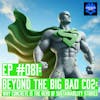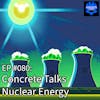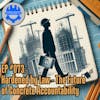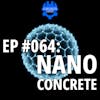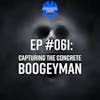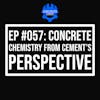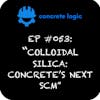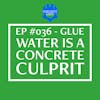EP #056: Concrete's Potential
🎧 Join us on the Concrete Logic Podcast as we explore the fascinating world of concrete alkalinity and its impact on the longevity of concrete structures. Our returning guest, Robert Higgins, sheds light on the changes in cement production over the last century, including the introduction of higher alkaline content due to EPA regulations. Discover how these changes have led to detrimental chemical reactions and increased permeability. If you’re a concrete enthusiast or industry professional, this episode is a must-listen. Gain a deeper understanding of concrete alkalinity and its implications for the future of concrete construction. Don’t miss out on this enlightening conversation with Robert Higgins on the Concrete Logic Podcast! 🔬👷♂️
Episode References
Guest: Robert (Bob) Higgins | RC Consulting | rcconsulting.higgins@gmail.com
Guest Website: https://www.linkedin.com/in/robert-higgins-b8294411/
Guest Charity: https://kidsrockthenation.org/
Producers: Jodi Tandett, Olivia Stocker
Become a Producer: https://www.concretelogicpodcast.com/support/
Music: Mike Dunton | https://www.mikeduntonmusic.com | mikeduntonmusic@gmail.com | Instagram @Mike_Dunton
Host: Seth Tandett, seth@concretelogicpodcast.com
Host website: https://www.concretelogicpodcast.com/
Donate to $5 to the show: https://buy.stripe.com/9AQ4gP8Mu83Z3045km
Seth: [00:00:00] Welcome to another episode of the Concrete Logic Podcast. Today, I have a returning guest, Robert Higgins. Robert, you had a very popular podcast. I will tell you, I got all kinds of feedback, positive, negative. When we discussed the vapor barrier and all that good stuff got a lot of attention So that was a good one.
But if y'all don't know Robert or didn't listen to that last podcast, he's a concrete consultant. He's been involved with professional groups, ICRI, CSI. He's done papers for the flooring industry. He's a moisture test instructor. And yeah, it's been involved with different committees within the, flooring and the concrete industry.
And Robert, did I leave anything out?
Robert: No, that pretty much covers it. [00:01:00]
Seth: He's been around a while and knows some, he knows a lot of things. But he agreed to come on the podcast. And we want to talk about concrete alkalinity and it's, the issues that it causes with concrete you want to get us started off, Robert, and I will try to you, you talk above our heads sometimes, so I'm going to try to bring you down to earth a little bit.
Okay.
Robert: Sorry. Yeah. Cause no, you're good. When you're a geek, you speak geekies,
Seth: That's right. We're all concrete nerds that listen to this podcast. So you're in the right spot.
Robert: Probably the best thing to discuss alkalinity to start with would be the history of concrete. A lot of times every time I read something, I say concrete's thousands of years old.
Yeah, that's true. But not Portland cement concrete. [00:02:00] Portland cement concrete is really the history of what we do, because that makes up 95% of the concrete used globally. I know there's other novel types, and there's even some bigger of it. Some, even some very large groups like CTS, for example, that have a calcium aluminate cement, but they're still of the minority.
Seth: I don't mean to interrupt you, but what, so what we're talking about is Portland cement. And would you say that the, history of of that type of concrete is roughly about a hundred years old? Is that what we're talking about?
Robert: Yeah, it's actually, it's about 200 years old, but it's fragmented. And that's what I wanted to point out is we have these different.
Milestones as we go through, we're basically the original Portland Smith that we were dealing with is no longer what we're dealing with today, but we're still [00:03:00] using the history of what we used back then. And there have been no alterations to accommodate these changes and I don't know why. And, that's why things keep getting worse and worse, and they're not being addressed.
They will, we're always doing what we did. So yeah, you're always doing what you did, but you're not getting the same product that you have. So you can't keep doing what you did with the older technology. You have to address what you're dealing with now. So if we go back in the 1920s and actually really the 1950s, where the real first significant shift was made they started.
Grinding the cement finer because he found that if you grind it finer, it will set up faster. And they thought, this is great. But in that discovery, they also found out that it generated a lot of heat, and so to somewhat compensate for that, and also had way more strength than they needed [00:04:00] at the 28 days that they started to establish as being the benchmark.
So according to a publication in Concrete International, which is a ACI publication, it was discovered and it was stated by Ed Monroe that the cement of, or actually the concrete in the 1980s had 34% less cement than the concrete of the 1950s. So if you put them side by side at 28 days and broke them, they would still break and say 3000 or 4000 or whatever they were designed for.
However, the permeability difference was, amazing. It was not in a good way. The concrete of the 1980s, they say was upwards of 500% more permeable. That was not taken into consideration.
Seth: That's not a good thing, folks.
Robert: No, it is not. So what they started to do [00:05:00] as the demands increased, they started putting some more cement back into the concrete.
So instead of going to a coarser grind because they didn't want the, delayed 28 day benchmark to start shifting to where they're not meeting those numbers, they just maintain a finer grind and they kept grinding finer and finer because it's called a Blaine particle size, whatever they want to call it, but what happens, and this one I'm going to explain to people, and this is why alkalinity is so important, the smaller the grain of the cement, as it begins to hydrate, it spins off it, makes cement.
The other thing it makes is calcium hydroxide. That's the main alkaline material that that's a byproduct of hydration. Now, that is a material that gives the concrete, its normal alkalinity, but that is not the prime alkaline component. [00:06:00] Even though it is the focus, it is not the prime alkaline component.
The prime alkaline component is actually contaminated, and that's it's called sodium hydroxide. Now that that's, that stuff's nasty. One, it's very high in pH. If you have a pH that's higher than 12.5, it is probably sodium hydroxide. Calcium hydroxide does not get past 12.5. There's some argument where, you know, where the geeks among us argue it can only get to 12.45.
There's not too many things that are accurate enough to pinpoint it like that, I accept 12.5 because you're going to get some influences where it can change a little bit, but you want to see at about 12 or higher. Now, when it gets to 13, you have a contaminant. Now, what that contaminant does and has been completely ignored when when [00:07:00] concrete's being developed and trying to cure it is that it has an inhibiting effect on the calcium hydroxide.
It makes it insoluble. Now, people think that's no big deal. It is a big deal, because about 85, between 85 and 90% of the hydration creates cement. 10 to 15% of it creates calcium hydroxide. That also covers part of the cement particle that hasn't hydrated yet. In the presence of sodium hydroxide, it becomes insoluble, so it doesn't react it doesn't absorb water, so that actually inhibits the water contact to the cement particle that needs to be hydrated.
And that hurts the hydration of concrete, so it said just keep it wet. That's all that's all well and good, but what happens as the cement's developing when you're trying to keep it wet, when you put water on the [00:08:00] concrete or cure it in some other fashion the, understanding was, and it was an incorrect understanding, was that the water will allow everything to hydrate and we keep it above 80% relative humidity.
Because relative humidity is really the the barometer that tells you whether or not cement development is occurring. It has to be above 80 percent relative humidity, otherwise cement development stops, no matter how much water is around. Which sounds strange, but that's, how it is because what happens, it becomes, it goes into this equilibrium thing that's, not being addressed properly and that's causing a lot of issues that I'm not going to cover in this podcast, but it lends itself to these other issues.
They're being investigated. So what happens as a cement particle develops, it consumes the water that's available. What it also does is it reduce the amount of water which [00:09:00] concentrates the alkalinity. Now, by concentrating the alkalinity, that brings the relative humidity down. There's a reciprocal.
Reduction of humidity as the concentration level of the alkaline material gets higher, for example, and that's, what bothers me because I read this in this National Institute of Standards and Technology study was was state of the art report in 1999. And I thought it was very interesting that they felt even back then, that uncracked and uncurled concrete was probably an unreasonable expectation of concrete.
And we've been told differently. How, why wasn't this being conveyed? It wasn't being conveyed because they didn't know what was causing it. So basically I'm going to give you the root cause of what causes that. This is where it starts. So [00:10:00] yeah. So if we look at that and I'll go back to the NIST study when that study came out, it said that sodium hydroxide as a concentrate lowers the freezing point of water.
That's true if it's really, dilute, but we don't have that anymore because now. We don't have that anymore because when it's diluted, it's when all that water is in there. What happens is as the water gets consumed, it gets concentrated. And what happens is it changes the properties of the water.
The water now starts responding. If you look at the freezing point of water when it's when you put sodium hydroxide in, it looks like a drunken mosquito. It goes all over the place, but it tends to go up. So what'll happen, and I found this in desert climates, where they couldn't dry the concrete out.
And I said, why can't we dry the concrete out? They couldn't dry it [00:11:00] out because the concentration level of the sodium hydroxide towards the surface of the concrete, when we took samples of it, the lab said it was between 50 and 60 percent concentration. When it gets to 40 percent concentration, the freezing point of water climbs to 59 degrees.
It's no longer 32 degrees. But everybody's treating it as that. They're not looking at the complexity of what's going on. So this creates a cascading effect. Where assumption upon assumption is made and they're not dealing with the root cause. Then as it concentrated further, you can actually get the free, you can actually push the freezing point of water past 100 degrees Fahrenheit.
And when people doubt that, I tell them, go look at, the bulk usage and distribution of sodium hydroxide. They keep it at 40% because at least that's manageable. But, in the bulk distribution, [00:12:00] sodium hydroxide, they heat the tanks and lines so the water doesn't freeze the sodium hydroxide and water doesn't freeze in the lines or in the tanks.
So otherwise it wouldn't be able to deliver the product.
Seth: So that's just salt, right?
Robert: Yeah, it's a salt. It's a metallic salt, but it's very, it has almost unlimited solubility. Whereas the calcium hydroxide has limited solubility, but here's, this, here's another sticking point. The calcium hydroxide becomes less soluble as the temperature increases.
So when you're placing concrete in sunlight, you got radiant heat and the sodium hydroxide is concentrating. That's dehydrating the concrete surface. They call that self desiccation. I was called out on that, so well, that's ridiculous. Everybody knows that it doesn't do that, blah, blah, blah. Study after study globally is showing now consistently [00:13:00] that the top one inch of the concrete is dehydrating and that self desiccation is bringing the relative humidity in the top three quarters of an inch to one inch of the concrete; down to 50 to 60 percent relative humidity.
So I was correct. The hypothesis did work and it's happening globally. Now let's fast forward to 2002. The EPA attempted back in 1990 to have the cement producers recover the flue gases. This one massive concrete producer, or cement producer, said I can't do that, it'll put us out of business, because we our, main business model is low alkalized cement.
So they gave them enough time to switch, so they started to implement this in 2002. So gradually... All the different cement producers finally conformed to this and it was apparently [00:14:00] pretty much 100% conformity to the EPA restrictions. Now what, really bothers me is this is underreported because he said no, no more low alkali cement.
Why? And I read two articles on that and they don't explain why. They just say it's not there anymore. And they also don't impress upon us how important that is because they don't understand it. The higher alkalinity triggers this where this dehydration is occurring so quickly, it's happening in the first two to three weeks of concrete placement.
So no matter how much water you put on the concrete, it will still dehydrate. Because what happens, they say it equalizes. Yeah, but that's called relative equalization. You can have a dry spot right next to a wet spot if it's alkaline enough. So they're in an unsteady alliance there.
So what [00:15:00] happens, you can be putting water on it all the time, and that's not going to help. So there's been this big push towards internal curing and self curing concrete, which I completely agree with. And they found, what's really ironic, is these absorptive aggregate used to be considered bad news for floors and other types of concrete.
Because these contain water and it was assumed not verified, but it was assumed this added to the water cement ratio. It did not because as long as it was, if it's saturated but surface dry, if you put this saturated aggregate into the mix, it gave these internal carrying points in the concrete that gave concrete greater density and had a more complete development of cement, because now you have a water source inside, not just on the surface.
So you have it scattered through, but it's uneven. So they're finding out that if there's not [00:16:00] enough of this, which there can't be, because they can't put in enough aggregate to really compensate for the the differences. What happens is they get different strains in the concrete. So they're getting areas of drying shrinkage and some areas are staying staying in a swelled position.
So what will happen is it could preach strain and starts cracking the concrete. So they're finding that doesn't cure it even though it's helped the concrete increases durability. It's just frustrating because they're not dealing with it. They're looking at the 28 day strength.
A 28 day strength evaluation is almost, in my opinion, worthless without a 365 day strength analysis on the same exact mix design, because what will happen if you place concrete in hot weather, say it's 90 degrees the 28 day strengths will be really impressive, but you'll have [00:17:00] a reciprocal reduction at 365 days. But again, study after study, they stopped 28 days.
They don't do the evaluation 365 days. So in my opinion, those are inconclusive. I don't know if they've actually improved the concrete because there's no verification at one year. We, the industry, should require 365 day verification, 28 days . Fine.. Good. Now we got this. Now you have to complete the study.
And everybody stops 28 days. So basically we're on a hamster wheel. We keep reinventing the wheel and not going any further to verify whether or not these studies and these techniques that we're adding to the concrete are really as helpful as we're hoping they would be.
Seth: And, this is all, just to catch up with you, here. So [00:18:00] we're talking about calcium hydroxide. Is that right?
Robert: Yes. Calcium hydroxyl is a natural alkaline component created by the hydration of cement.
Seth: It's also known as hydrated lime.
Robert: Yeah. It's also called Portlandite. Yes.
Seth: Okay. Is that different from the limestone?
Robert: Yes. Limestone is calcium carbonate, hopefully.
Hopefully they don't use sodium carbonate because that can create all kinds of issues. I don't know. Okay. But the limestone, yeah, it's different and I'm not a fan.
Seth: Right. Yeah. We're, learning as we go here.
Can you go back to, again you, mentioned it, the cement kiln dust. [00:19:00] All right, can you go back and I guess maybe explain again how this has impacted the cement process and why it took that manufacturing cement manufacturer so long to agree to do it? Why, were they not on board initially in the early 2000s?
Robert: Okay. Oh, thank you. Yeah, you got to reel me in sometimes because I get off on these tangents . when, It's called cement kiln dust or CKD for short. CKD was is produced it, so when they recover the flue gases and part of that recovery process, they wanted the cement kiln dust. At least some of it to be reintroduced in the cement process and that's been done now.
Seth: Why, did they want that?
Robert: Because it reduces pollutants, not just carbon dioxide, but pollution because there are other pollutants that it was releasing [00:20:00] into the air. So they wanted them to recover that. There's no consistency with this because when you locally source minerals, they're going to have natural variations in alkalinity and other chemical makeup or one type of limestone in the Dakotas will be different than Northern California.
Northern California will be different than Central California and so on. So when you go to different regions, there's going to be variation. So when they recover the cement kiln dust does the alkalinity of the cement considerably. One estimate, which I'm sorry I didn't screenshot because this page has been removed from the internet, which that bothers me as well, showed that some of this alkalinity was increased by over 400 percent.
Now, here's the thing about alkalinity. It doesn't necessarily reciprocate with a pH test. [00:21:00] Everybody uses the pH test. Look, it's in the 13s. Yeah, but it's 13 what? Because when you look at the pH scale that's, a logarithmic scale. 13 and to a 13.2 is twice as alkaline.
And you go from 13.2 to 13.4, that's twice as alkaline. So that's, a bunch. That's just a minor change. That's a bunch. So if it gets four times more alkaline, it's instead, even though it will measure 13 on a pH strip or pH meter, whatever you want to use. 'Cause these things are not all that precise.
That that's hidden out in the open, so it can be more concentrated, but it's not as damaging, because I've shown this where I've taken sodium hydroxide, if you get Drano, [00:22:00] the powdered Drano, that's sodium hydroxide. I took one tablespoon of that, I put in a cup of water, stirred it up, it hit 13.
I put in nine more tablespoons, stirred it up. It was still 13. Now, the one tablespoon, I could put it on on a painted surface and nothing would happen. When I took the concentrated, I put it on a painted surface, it dissolved the paint. Now, that concentrated material will also dissolve rock. It will dissolve anything that's amorphous.
So even though it's 13, it can actually dissolve rock. It'll actually create its own sodium silicate in the concrete. And that kind of sodium silicate is expensive. We're, causing damage to our own concrete by adding this crap and then by it dehydrating like that. It's concentrating towards the surface.
So it's the top inch of the concrete is [00:23:00] suffering. Now, what was really interesting is the Texas Transportation Institute. Dr. Dan Zollinger did a study on this and he decided to look at uncured versus cured concrete in a laboratory setting. So he did uncured concrete, he did cured concrete. The cured concrete was water cured in a lab under laboratory conditions for seven days.
Since he was curious about the gradient portion of the concrete, which is the top inch, he went ahead and sliced off the top inch of the concrete. Even after seven days carrying water cure, it was 20% weaker than the remainder of the concrete. Now, here's where we, hit our heads.
In the compressive value test when you crush concrete, you crack it.
That's like compression it can have with a weakened surface will not show up in the test. That goes hidden. A good way to evaluate is probably a rebound hammer, but that's been discredited because it [00:24:00] always shows that the concrete is weaker than it is. Actually, it may have been showing us exactly how weak the surface was compared to the rest of the concrete.
So there, there may be a value in there that we've, that's been hiding out in the open. Yeah. So that Dr. Zollinger proved that topage to the concrete is considerably weaker, even with a seven day water cure. And this is going to get worse because as concrete is placed in the field and subject to a radiant heat from the sun. We're going to get worse and worse concrete.
Now what's bothersome about this is the ready-mix producers are required to disclose anything that's in the concrete; such as if they're a plasticizer, they put in fly ash, anything like that. The cement producers, I have not seen any requirements of what they have to disclose.
Because they are adding [00:25:00] cement grinding aids. And some of these grinding aids may be actually interfering with coatings and floorings. Because some of these grinding needs are amine-based and glycol based. These are not stable, they can migrate through the concrete. So we're adding all these complexities and there's no data on what this can actually do to your concrete.
So if we address these issues and we show how to deal with them because these can all be compensated for if we make the concrete self curing. So I'm a big proponent of that. If we make concrete self-curing and I really don't want to get proprietary, but I have to because I investigated the different compounds and the different additives and things of that nature.
There is a nano colloidal silica that I saw that blew me away. They did an analysis in Purdue University. And for the very first time [00:26:00] that I've ever seen, the surface of the concrete was actually denser than the remainder of the concrete. Yeah. not weaker, not more porous, not more permeable.
In fact, the density improvement was about 78% over that of standard concrete. That's waterproof concrete.
Seth: Yeah
Robert: That is and it's not expensive. The stuff costs less than a shot glass. So if you add this into the concrete, and you produce waterproof concrete. All this stuff is no longer applicable.
Because what happens is the, alkalinity within the concrete is no longer mobile. It's not collecting, it's not going through these capillaries, it can't concentrate. And by adding a water source, which these little things do, because if you look at a colloidal silica, it contains its own water. So as it reacts, it releases water.
So these things are tiny. If you take a [00:27:00] five gallon bucket of colloidal silica, the comparative, I like this one comparative that I read about from this research research company, where they said that the equivalency of, an entire football field in surface area in a five gallon bucket. So that surface area gives an evaporable face.
By evaporating water inside the concrete, you naturally cool it. So it takes care of the water source, and it takes care of the overheating, which are the two deadly combinations for concrete today. Because it is the top edge of the concrete that's causing the issues.
Seth: NIST has a whole page of references for internal curing of concrete, or they, I can't even read through every, they got a list of [00:28:00] all kinds of studies done.
Robert: Yeah, super absorbent polymers and that kind of thing. Yeah, there's all kinds of studies being done. Because they know that's where the curing of this issue is really buried. Is you need to have internally cured concrete. It needs, concrete needs to be self curing. Because if it's done you don't even need a curing agent.
That's the other thing. I've seen concrete being placed and when it was done in Oregon, and I was really impressed because they placed the concrete and the surface stayed damp for hours. So basically it was producing its own water during the hydration process. And then, I said what I'd love to do because If I'm correct in my in my hypothesis here, I believe the concrete will be almost waterproof within two weeks.
And this [00:29:00] gentleman went out to go test it after two weeks, but unfortunately it rained that day and he was waiting and gee, rained in Oregon. Imagine that. So anyway, he found a couple of dry spots and he took the Tramex meter and put it down.
He said I'll be damned, Bob. It's 4. 7 on the Tramex meter, two-week-old concrete. It should have been up around 6, 6. 9, not 4. 7. And that, is because that averages out the first three-quarters of an inch of the concrete. So it's actually drier toward the surface. So that in my opinion is ready to, as soon as the surface is dry from where you don't see any water on it, blow a fan across it for about an hour, you can install a floor.
Two weeks.
Seth: Yeah. We've talked about that on a couple of episodes, internal curing. And if it's done right. [00:30:00] Yeah, you don't have to wait.
Robert: But see, we can't do surface carrying anymore because it doesn't get the job done anymore. We have to rethink our entire approach because the concrete we're dealing with today is not the concrete that was established when the carrying standards were made.
When the carrying standards were made in 1950, and they haven't changed. We're working with a different product. It's changed again. And it changed again dramatically between 2002 and 2018. When the big announcement came out in 2019, no more low alkali cement, that's when everything changed.
We're now dealing with a new product. This Portland cement is not the Portland cement of 1950. It's not even the Portland cement of 1980. It's not the, it's not any Portland cement prior to 2002. It is different now,
Seth: Right. All because of the cement.
Robert: Yes, with the cement kiln dust, [00:31:00] it is now different in each area where the cement is being produced.
It'd be really nice if we can get a an alkalinity baseline in each one of those producers. I don't think they'd be very forthcoming about that, but it would be nice if we could do that.
Seth: Yeah, we would have to do that at each plant.
Robert: Yes.
Seth: There's only a couple of companies out there produce cement.
They got it all wrapped up. 48 plants total.
Robert: Yeah.
Seth: Over what, two companies?
Robert: Probably. Yeah. It's, yeah, it's a bit of a monopoly. If you could say, do
Seth: A duopoly?
Robert: A duopoly. Yeah. There we go. A. Yeah, but each plant has to be evaluated because they're the mineral extraction is different because it's so we should have a localized [00:32:00] baseline.
So we don't have to how to deal with it because some won't take as much effort as others.
Seth: Yeah, so each plant is probably using different grinding agents too, right?
Robert: Yes, because it depends on the mineral. If it's a harder, softer mineral, they would use a different grinding aid.
How
Seth: How much cement, kiln dust is getting in the cement?
Robert: I've looked that up and I cannot find any numbers on it. At once upon a time it was brought up, but they just said that percentage of the kiln dust is being reintroduced. I don't know what that percentage is, and they don't, and they're not being very forthcoming about what the percentage is.
What percentage that is of the cement itself.
I don't know.
Seth: Because they produce a lot of cement kiln dust, right? It's, there's a lot to handle for [00:33:00] them.
Robert: Yeah. And it can, and if they recycle it, it can be usable because it can be used in in sub base and things of that nature, because it can be a really beneficial material because there's some products out there, and there's other chemicals out there that are, they're called pH responsive.
So if you get a pH responsive additive you putting with this waste kiln dust, you can actually create bricks and it's own kind of a non concrete paver out of it just for like secondary roads and that kind of thing. But I don't know how much that's being explored.
Seth: Interesting. Did we, do we hit on every point that you wanted to make today
about this topic?
Robert: Yes because, so many, [00:34:00] because one of the, one of the tests they do in the flooring industry is they put in the RH probe. What I don't like about that is one, it doesn't tell you how much moisture is in there. It can't because it just measures airspace.
And the other thing, they drill it in two inches and completely bypasses the problem area. Why are you testing where the concrete's good?
Seth: They want good results.
Robert: Yeah, exactly. I saw this other push where there were some in the concrete industry trying to promote E96 as a, as an evaluation of cement the concrete permeability, the top inch of the concrete and evaluate it.
I don't know if it's by design or by ignorance of the chemistry, but that's a trick. Because if concrete's alkaline enough and you use E96, which uses a [00:35:00] desiccant or uses an evaporative force, what'll happen is you will get good results 'cause concrete's really alkaline because it doesn't evaporate. The water doesn't evaporate readily if the alkalinity is high because it's competing forces, this is drawing and this is drawing.
So they, cancel each other out. Oh, look how good it is. Boy, we're not drawing any moisture out of there. It could be saturated.
Seth: Yeah. I've been on jobs where the concrete cures it like if you were baking a cake and you, you put the oven on too high. And it burns the outside and keeps the inside all moist and everything doesn't bake the inside.
Robert: Yep.
Seth: Yeah, that's a terrible situation to be in .
Robert: We're baking a lot of cakes out there.
Seth: Yeah. And we could keep on talking because there's there's admixtures and, [00:36:00] different things that are being added to specifications to, to address protecting the rebar.
That's probably not helping our cause either.
Robert: Yeah, because they don't look at cause and effect and unfortunately, one of the trends I've seen over the last 30 years, which is really unfortunate is they're evaluating first in the laboratory and then they go in the field. Then they keep bumping their head and go, why this happened?
Why this happened? Why this happened? One of the reasons why I liked the the one product I won't mention here. Cause again, that'd be proprietary. He tested it out on his own concrete and he did so for over 10 years, is a concrete finisher. The guy, so he was putting out his own concrete. He experimented on himself.
So when it was perfected and started working where he wasn't [00:37:00] getting map cracking, wasn't getting any curling. Then he knew he had a product. Then he brought it into the university study, and that's when Purdue did that study when I saw that they, where they did the admixture and then just a spray finish, not a curing compound, but a spray finish they didn't need to cure it and the concrete surface was actually denser than the remainder of the concrete.
I told him, I've never seen this before.
Seth: It's cool. It's a cool product. I've been trying to poke holes in it. I haven't been successful in that yet.
Robert: No, I haven't either. And I tried for almost two years to poke holes in it.
Yeah. Good deal. I think we'll end our alkalinity discussion today.
Seth: Usually at the end of the episode, Robert I, usually let you share how folks can get ahold of you. And I always give that information [00:38:00] out to our folks that follow the podcast. And also when I email our weekly newsletter out, and you've been on the podcast before and you're not a guy that's hiding.
So I think everybody knows how to get ahold of you. But I think what would be cool today is if you don't mind sharing that charity you shared with me yesterday.
Robert: Very much thank you for doing it. I contribute to a single charity. It's called Kids Rock the Nation. And it was started by a gentleman by the name of his, his stage name is Anthony Wild, but it's actually Anthony Klepper. He was a musician locally in the Daytona Florida area who got cancer and it was going to kill him.
He had no insurance. He had no way to pay for it. But a doctor basically took him under his wing and saved his life. He said, how can I ever repay you? He said, by passing this forward. [00:39:00] Helping kids is a good start. So what Anthony looked at, he saw that a lot of these kids, especially the underprivileged kids, had no outlet for their energy.
So he thought why don't we start providing them with with musical instruments and see how this goes?
He started doing it, and right from the get- go, it was successful. The kids became focused. They got better at school. So that idea grew into something. And when I moved here in 2012, I saw, I noticed this and I kept observing what he was doing, and I was so impressed.
I thought this, is the way we got to go. So I started donating the guitars I had. I've donated at least 30 guitars so far, a couple PA systems that went to some of these schools and some of these individual kids, because not only do they give it to individual children, but they give it to these school districts that don't have the budget to get musical [00:40:00] instruments.
And this is happening around the country now. And what's really cool is they have now gifted over 2,000 children the gift of music. And one of the very first ones back in 2013 just got signed by Sony Records. This child had no direction, was given a guitar, and they showed an aptitude towards it, so they continue to help him, because they don't just give him something and then abandon him.
They will work with him, especially the ones that continue to show interest. He's now a professional musician.
Seth: That's awesome.
Robert: Successful career. I was so excited. I had a couple of cherished actually several cherished musical memorabilia that I had, and I donated those as well. The one with the biggest impact was I had one [00:41:00] of B. B. King's guitars.
Now B.B. King. It was one of, the most generous people I've ever met. I got to meet him. I got to talk with him. He's one of those kind where you're sitting in a room with him, you're the only person there. That's how engaging he is. He donated several of his guitars, and I purchased one at a child kids charity in San Diego.
So basically, when I donated it to this charity, it just went full circle. So it was great because I hate to put it this way, but now that after B.B. King passed, the guitar was worth a fortune. So what they were able to do is get the equivalent of gifting kids guitars and musical instruments for the next 10 years off that one donation.
So I'm really proud of that.
And, anybody here in this podcast, look them up. I'll tell you what, we need to get [00:42:00] this around the country really strong. 'cause we have a bunch of professional musicians jumping on board with this and this has really been successful.
And a hundred percent of the proceeds go right to the kids.
Seth: We'll put it, their website in the show notes. KidsRocktheNation.org. I was blown away when you shared that story yesterday. I didn't even know that existed.
Hopefully, someone or some folks that are listening to this will reach out.
And again, I thought that was pretty cool. Robert. And what you're doing with them. So that's awesome. All right. Yeah, so I think we'll end the episode today.
Remember folks, the future of concrete is not set in stone. It's up to us to shape it. Follow us on whatever podcast app you like to follow us on, please check out the website, concretelogicpodcast.com. And [00:43:00] Robert, thanks again for doing the show.
Robert: I do want to add one more thing. If we take the concrete design with, the admixture and the topical that we're talking about, I believe that we can produce concrete that will rival Roman concrete in its ability to withstand hundreds of years, not decades.
Now how much greener and more sustainable can you be?
Seth: I don't know. We keep beating that drum on this podcast, Robert. Hopefully, it'll sink in soon.
Robert: I hope so.

Robert Higgins
Involved with waterproofing and restoration of buildings and specialized in concrete. Have been involved with several committees with professional groups such as ICRI (first chair for moisture testing), CSI, speaking at national and regional conferences, authored the Flooring industry “White Paper” for the WFCA (World Floor Covering Association), moisture test instructor for the Academy of Textiles and Flooring, guest instructor for ICRI. Authored many articles regarding weather and environmental durability of concrete in multiple publications. Currently involved with IICRC Committee S230 and NFCA (National Floor Covering Association) “best practices” for moisture testing concrete prior to installation of Floor Materials.








